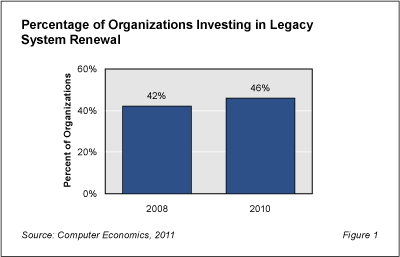Computing technology has come a long way over the past decade. But legacy business systems—often written in COBOL and running on big iron—continue to comprise the core of many mission-critical computing systems.
During the run-up to Y2K, many organizations favored a course of remediation over rip-and-replace strategies. Today IT managers are coming to the same conclusion: the safest and wisest course is to extend the life of their legacy systems through modernization projects.
Our study on Legacy System Renewal Adoption, ROI, and TCO indicates that there is a sustained level of activity surrounding legacy system renewal. Figure 1 shows that 46% of organizations in 2010 were either implementing or expanding renewal initiatives, an increase from 42% in 2008.

Because such projects can be long, ongoing affairs requiring multiyear commitments, this is not surprising. We would expect current investment activity to be sustained at this level for several years.
While renewing legacy systems can be a daunting task, doing nothing is not an option. Mission-critical legacy systems are expensive to maintain. They often lack the flexibility for integrating data, applications, and services to take advantage of Internet-enabled business processes. COBOL programmers and other personnel needed to maintain the systems are becoming increasingly scarce and expensive as baby boomers reach retirement age. And replacing legacy applications with new packaged applications can be even more expensive, more risky, and more disruptive to entrenched business processes.
The decision whether to renew or replace legacy applications is an economic one with which many IT managers are wrestling. In the full study, we assess current adoption and investment rates for legacy system renewal projects based on our annual survey of 200 IT organizations. Next, to determine risks associated with renewal projects we look at the return on investment (ROI) and total cost of ownership (TCO) experiences of organizations that have undertaken such projects. Finally, we examine trends by organization size and conclude with a summation of best practices.
This Research Byte is a brief overview of our report on this subject, Legacy System Renewal Adoption, ROI, and TCO. The full report is available at no charge for Computer Economics clients, or it may be purchased by non-clients directly from our website (click for pricing).

